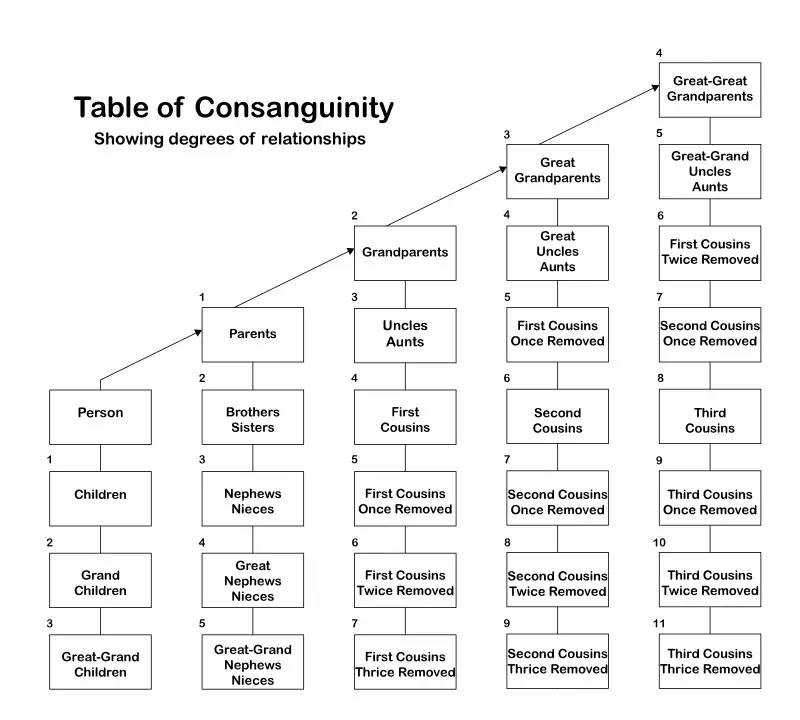Do you want to know the definition of consanguinity? In this article, you will find an easy-to-understand explanation of the concept of consanguinity, along with a few examples.
You will also learn:
- The origins of the term "consanguinity"
- What are degrees of consanguinity
- What is consanguinity in genetics?

This is one of those topics that seems complicated, but it's really pretty easy to understand. Below, find out everything you need to know to understand the basics of consanguinity.
What does Consanguinity mean?
Consanguinity is genealogical or genetic relatedness, or being descendants of the same common ancestor. When two people are related, we describe their degree of consanguinity, or kinship.
In other words, people who have consanguinity are people who, by birth, belong to the same family. The common ancestor can be as recent as a parent, or more distant than a great-great-great-great-great grandfather.
We can describe the relationship between two people who are related in any way as having consanguinity. Relatives who have consanguinity to us can be as closely related as a parents, identical twin, first cousins, or as distantly related as a 5th cousin, or more.
Here are a few examples of how to use the word consanguinity:
- Everyone in my family tree has different degrees of consanguinity to me.
- If the man is your father, the results of your blood tests will reveal your consanguinity.
- Many places prohibit marriage between individuals with very high consanguinity.
- Relatives with significant consanguinity have close relationships and are likely to provide financial support to one another.
If you want to use consanguinity as an adjective, you can say "consanguineous". Two people can be consanguineous because they are related by blood.
Consanguinity is a very interesting word, even if not very commonly used in daily speech, and we do see it used in genealogy discussions. Keep reading below to find the fascinating origins of this word.
Origin of the word "consanguinity"?
The English word consanguinity is derived from the Latin word cōnsanguinitās. Con in Latin means together, and sanguineus, which means, literally, blood.
When used as an adjective, sanguineus means of blood, which means that consanguinity literally means together, of blood.
When you think about the literal definition of the word, it can help us feel a little closer to our relatives. After all, our consanguineous relationship to our family members should count for something, right?
Degree of consanguinity meaning
Degree of consanguinity means, simply, the degree of relatedness. This is often expressed in a number that is calculated beginning from one person, counting back to the common ancestor, and then down generations to the relative.
A lower number for the degree of consanguinity means a closer genealogical, and usually, genetic relationship. Conversely, higher degrees of consanguinity indicate a more distant relationship.
For example, siblings have two degrees of consanguinity. This is because we begin at one sibling and count back one generation to the common ancestor (the parent/s) and forward one generation to the other sibling, equaling two degrees.
More distant relatives will have higher degree of consanguinity. Take, for instance, second cousins who share great-grandparents as a common ancestor.
Second cousins have six degrees of consanguinity because there are three degrees back to the common ancestor (great-grandparents) and three degrees forward to the other second cousin.

This image was created and generously shared by WClarke based on original by User:Sg647112c - Own work, CC BY-SA
The table above illustrates degrees of consanguinity. It is interesting to note that there are multiple relatives that fit the same degree of consanguinity.
This happens because when we count back to the common ancestor and then forward to the other relative, we get the same number. This is equal to the degrees of consanguinity.
For example, we note that second cousins have six degrees of consanguinity, as do first cousins twice-removed. First cousins once-removed have five degrees of consanguinity, as do a great-grand uncle and a great-grand niece.
Consanguinity in genetic genealogy
In genetics, and specifically genetic genealogy, we refer to consanguinity simply as the degree of genetic relationship. We expect more genetic consanguinity in closer relationships, and less in more distant ones.
We have less genetic consanguinity with our more distant relatives because we tend to share less DNA with our family members as we move out from our position on the family tree. Genetic genealogists use the amount of shared DNA to estimate relationships to DNA matches, which are genetic relatives typically found on autosomal DNA test results like Ancestry DNA or 23andMe.
Interestingly, the degree of consanguinity in the chart posted in the previous section of this article can provide clues as to how much DNA we might expect to share with a relative. No matter the relationship, relatives with the same degree of consanguinity will share DNA that falls into the same range.
As we noted in the previous section, both second cousins and our first cousins twice-removed have six degrees of consanguinity. The majority of our relatives of both of these relationship types will share between 150-350 centimorgans with each other.
I find it useful and interesting to think about DNA shared between relationships and consanguinity - especially degrees of consanguinity. This helps us more easily understand the origins of some of our cultures, traditions, and even legal practices.
You can read more about shared DNA and how it is used to estimate relationships by reading the following article:
Conclusion
I hope that this post helped you better understand the idea of consanguinity, and that the examples helped illustrate the concepts. Consanguinity is an uncommon word, but the ideas behind it are important for genealogy.
If you have any questions about something that you read in this post, or if you would like to share a specific example of consanguinity, I would love to hear from you in the discussion below.
Thanks for stopping by!

Mary Chura
Wednesday 16th of December 2020
The 1840 US census does not include children by name, hence how can one prove the parentage of those born in 1831 in Virginia, and then moved to another state in 1850? Brick wall for me.